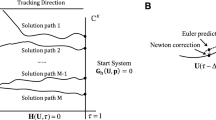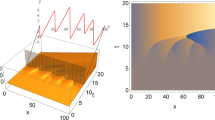Abstract
We consider Turing-type reaction-diffusion equations and study (via computer simulations) how the relationship between initial conditions and the asymptotic steady state solutions varies as a function of the boundary conditions. The results indicate that boundary conditions which are non-homogeneous with respect to the kinetic steady state give rise to spatial patterns which are much less sensitive to variations in the initial conditions than those obtained with homogeneous boundary conditions, such as zero flux conditions. We also compare linear pattern predictions with the numerical solutions of the full nonlinear problem.
Similar content being viewed by others
References
Bard, J. B. L., Lauder, I.: How well does Turing's theory of morphogenesis work? J. Theor. Biol. 45, 501 (1974)
Bunow, B., Kernevez, J. P.: Turing and the physico-chemical basis for biological pattern formation. (preprint) (1980)
Bunow, B., Kernevez, J. P., Joly, G., Thomas, D.: Pattern formation by reaction-diffusion instabilities: application to morphogenesis in Drosophila. J. Theor. Biol. 84, 629 (1980)
Catalano, G., Eilbeck, J. C., Monroy, A., Parisi, E.: A mathematical model for pattern formation in biological systems. Physica (3D), 439 (1981)
Edelstein, B. B.: The dynamics of cellular differentiation and associated pattern formation. J. Theor. Biol. 37, 221 (1972)
Gear, C. W.: Numerical initial value problems in ordinary differential equations. Prentice Hall (1971)
Gierer, A.: Generation of biological patterns and form: some physical, mathematical, and logical aspects. Prog. Biophys. Molec. Biol. 37, 1 (1981)
Hadeler, K. P., an der Heiden, Rothe, F.: Nonhomogeneous spatial distributions of populations. J. Math. Biol. 1, 165–176 (1974)
Hunding, A.: Dissipative structures in reaction-diffusion systems: numerical determination of bifurcations in the sphere. J. Chem. Phys. 72(9), 5241 (1980)
Jones, D. S., Sleeman, B. D.: Differential equations and mathematical biology. George Allen and Unwin, London (1983)
Kauffman, S. A., Shymko, R. M., Trabert, K.: Control of sequential compartment formation in Drosophila. Science 199, 259 (1978)
Lewis, J., Slack, J. M. W., Wolpert, L.: Thresholds in development. J. Theor. Biol. 65, 579 (1977)
Meinhardt, H.: Models of biological pattern formation. Academic Press, London (1982)
Murray, J. D.: Nonlinear differential equation models in biology. Clarendon Press, Oxford (1977)
Murray, J. D.: A prepattern formation mechanism for animal coat markings. J. Theor. Biol. 88, 161 (1981a)
Murray, J. D.: On pattern formation mechanisms for lepidoptera wing patterns and mammalian coat markings. Phil. Trans. Roy. Soc. B 295, 473 (1981b)
Murray, J. D.: Parameter space for Turing instability in reaction-difiusion mechanisms: a comparison of models. J. Theor. Biol. 98, 143 (1982)
Schnakenberg, J.: Simple chemical reaction systems with limit cycle behaviour. J. Theor. Biol. 81, 389 (1979)
Seelig, F. F.: Chemical oscillations by substrate inhibition. Z. Naturforsch 31A.2, 731 (1976)
Thomas, D.: In: Thomas, D., Kernevez, J. P. (eds.) Analysis and control of immobilized enzyme systems, p. 115. Springer, Berlin, Heidelberg, New York (1976)
Turing, A. M.: The chemical basis of morphogenesis. Phil. Trans. Roy. Soc. B 27, 37 (1952)
Wolpert, L.: Positional information and pattern formation. Curr. Top. Dev. Biol. 6, 183 (1971)
Author information
Authors and Affiliations
Additional information
This work supported in part by U.S. Army Grant DAJA 37-81-C-0220 and the Science and Engineering Research Council of Great Britain Grant GR/c/63595
Rights and permissions
About this article
Cite this article
Arcuri, P., Murray, J.D. Pattern sensitivity to boundary and initial conditions in reaction-diffusion models. J. Math. Biology 24, 141–165 (1986). https://doi.org/10.1007/BF00275996
Received:
Revised:
Issue Date:
DOI: https://doi.org/10.1007/BF00275996




